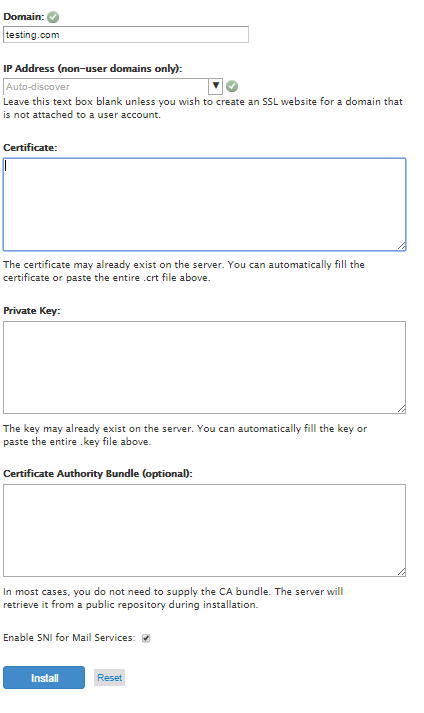The following instructions will guide you through the SSL installation process on Web Host Manager (WHM). If you have more than one server or device, you will need to install the certificate on each server or device you need to secure.
What You’ll Need
1.Your server certificate
This is the certificate you received from the CA for your domain. You may have been sent this via email. If not, you can download it by visiting your Account Dashboard and clicking on your order.
2.Your intermediate certificates
These files allow the devices connecting to your server to identify the issuing CA. There may be more than one of these certificates. If you got your certificate in a ZIP folder, it should also contain the Intermediate certificate(s), which is sometimes referred to as a CA Bundle. If not, download the appropriate CA Bundle for your certificate.
3.Your private key
This file should be on your server, or in your possession if you generated your CSR from a free generator tool. On certain platforms, such as Microsoft IIS, the private key is not immediately visible to you but the server is keeping track of it.
Installation Instructions
1. Log in to WHM
2.Go to your Homepage

3.Click Install an SSL Certificate on a Domain

4.Type in your domain name

5.Input your Certificate Files

- Certificate – This is your server certificate that was issued to your domain(s).Note 1: WHM should automatically fetch the Certificate (CRT) text if you previously uploaded the server certificate on the server and entered the correct domain name above. Note 2: If you received the certificate in a ZIP file, click “Extract All” and then drag your server certificate into a text editor such as Notepad. This will allow you to copy all text contents needed including “—–BEGIN CERTIFICATE—–” and “END CERTIFICATE—–“.
- Private Key – This is your private key that was created during the generation process.Note 1: WHM should automatically fetch the Private Key text if you previously created the Certificate Signing Request (CSR) in the “Generate an SSL Certificate and Signing Request” section of your SSL/TLS Manager and entered the correct domain name above.Note 2: If you made the CSR and private key outside of your WHM account and failed to save the files, you will have problems proceeding and may need to re-issue the SSL certificate with a newly created key pair.
- Certificate Authority Bundle (optional) – These are your intermediate certificates that allow browsers and devices to understand who issued your trusted certificate.Note 1: WHM automatically fetch the CA Bundle from a public repository. If you forgot to save these files, download the appropriate CA/Chain Certificate for your certificate. Note 2: If you have multiple intermediate certificates, paste each of them one after another to create the correct certificate chain/path.
8. Click Install
Once you’ve inputed the Certificate Files into the correct boxes, click Install.
Note 1: You are not required to “Enable SNI for Mail Services”. Server Name Indication (SNI) should only be used if multiple hostnames are being server over HTTPS from the same IP address.
Note 2: You or your web host may need to restart the Apache server before the certificate will work.
Congratulations! You’ve successfully installed your SSL certificate! To check your work, visit the website in your browser at https://yourdomain.com and view the certificate/site information to see if HTTPS/SSL is working properly. Remember, you may need to restart your server for changes to take effect.


